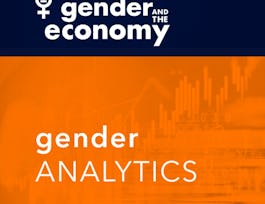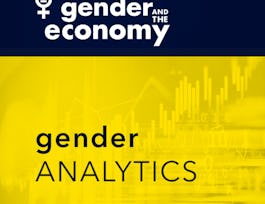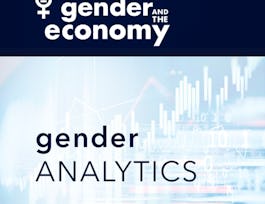Many policies, products, services or processes that we think of as gender-neutral actually have gendered outcomes. Everything from snow plowing to car safety to investment advising to infrastructure investment has impacts that differ by gender. These outcomes can be even more biased if we look at important intersections with race, indigeneity, differences in ability, ethnicity, sexual orientation, and other identities. The question is, what can you do to change this? And, how can you avoid the risks of bias or create innovative new offerings using gender-based insights?


Inclusive Analytic Techniques
This course is part of Gender Analytics: Gender Equity through Inclusive Design Specialization
Taught in English
Some content may not be translated



Instructors: Sarah Kaplan
2,796 already enrolled
Included with 
Course
(74 reviews)
What you'll learn
Understand legal & ethical frameworks for collecting, storing, analyzing, and disseminating data to reduce vulnerabilities for marginalized people.
Examine how quantitative data is produced, identify gender-related data gaps; & use analytics skills to uncover intersectional gender-based insights
Collaborate with stakeholders to gain an in-depth understanding of unmet needs using community-based and ethnographic research methods
Learn quantitative & qualitative research and analysis techniques; explore how to integrate insights from both types of data to generate insight.
Skills you'll gain
Details to know

Add to your LinkedIn profile
5 quizzes
Course
(74 reviews)
See how employees at top companies are mastering in-demand skills

Build your subject-matter expertise
- Learn new concepts from industry experts
- Gain a foundational understanding of a subject or tool
- Develop job-relevant skills with hands-on projects
- Earn a shareable career certificate


Earn a career certificate
Add this credential to your LinkedIn profile, resume, or CV
Share it on social media and in your performance review

There are 4 modules in this course
When collecting and analyzing data from diverse communities, it is important to recognize that this can create vulnerabilities for marginalized individuals and groups. In this module, you will learn about the legal frameworks and ethical requirements related to collecting, storing, analyzing, and disseminating data, paying attention to different country contexts. By the end of the week, you will understand potential risks to research participants and find ways to mitigate such risks and appropriately compensate them for their time and efforts in the data collection and design process. These considerations are important to take into account before you move forward with any data collection and analysis projects.
What's included
6 videos4 readings1 quiz2 discussion prompts
This session will review basic principles of quantitative data analysis, including probability and hypothesis testing, through fun examples and exercises. By the end of the week, you will be able to conduct basic calculations to analyze quantitative data and develop the intuition behind statistical inference and hypothesis testing to understand analytical reports generated by others.
What's included
8 videos3 readings1 quiz
This week, we will shed light on how data is produced and how to uncover gender-based insights from data. By the end of the week, you will understand the data generation process, know where to locate sources of gender-disaggregated data, and analyze relationships to interpret results. You will see how emerging insights from gender-disaggregated data analysis can shape the evolution of the problem statement and identify areas for further data collection.
What's included
7 videos2 quizzes
A big part of applying a gender lens to data analysis is obtaining different perspectives, especially from underrepresented groups. One way to do this is through qualitative research in the communities of interest. This week, you will explore the art of meaningful community engagement. By the end of this week, you will have a better understanding of the concept and value of community engagement as a qualitative data source. You will learn the steps to collect and analyze qualitative data to gain insight into people’s emotions, motivations, aspirations, and pain points. You will also learn how engage responsibly with vulnerable or marginalized communities.
What's included
12 videos3 readings1 quiz
Instructors

Offered by
Recommended if you're interested in Business Essentials

University of Toronto

University of Toronto

University System of Georgia

University of Toronto
Why people choose Coursera for their career




Learner reviews
Showing 3 of 74
74 reviews
- 5 stars
83.78%
- 4 stars
14.86%
- 3 stars
0%
- 2 stars
0%
- 1 star
1.35%
New to Business Essentials? Start here.

Open new doors with Coursera Plus
Unlimited access to 7,000+ world-class courses, hands-on projects, and job-ready certificate programs - all included in your subscription
Advance your career with an online degree
Earn a degree from world-class universities - 100% online
Join over 3,400 global companies that choose Coursera for Business
Upskill your employees to excel in the digital economy
Frequently asked questions
Access to lectures and assignments depends on your type of enrollment. If you take a course in audit mode, you will be able to see most course materials for free. To access graded assignments and to earn a Certificate, you will need to purchase the Certificate experience, during or after your audit. If you don't see the audit option:
The course may not offer an audit option. You can try a Free Trial instead, or apply for Financial Aid.
The course may offer 'Full Course, No Certificate' instead. This option lets you see all course materials, submit required assessments, and get a final grade. This also means that you will not be able to purchase a Certificate experience.
When you enroll in the course, you get access to all of the courses in the Specialization, and you earn a certificate when you complete the work. Your electronic Certificate will be added to your Accomplishments page - from there, you can print your Certificate or add it to your LinkedIn profile. If you only want to read and view the course content, you can audit the course for free.
If you subscribed, you get a 7-day free trial during which you can cancel at no penalty. After that, we don’t give refunds, but you can cancel your subscription at any time. See our full refund policy.


